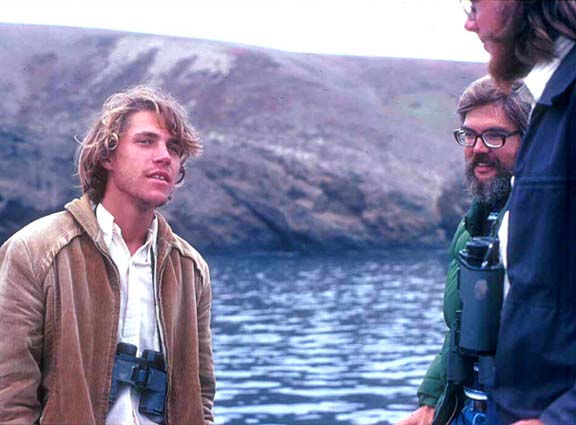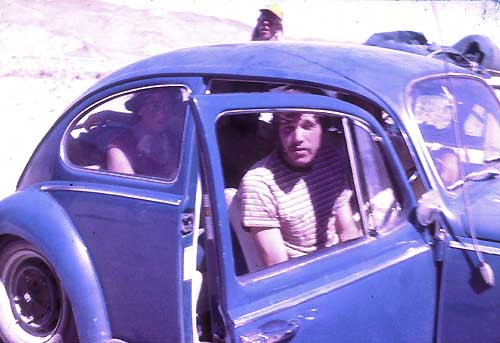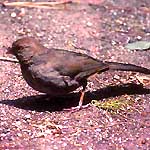 Dick
Erickson has long been one of California's more avid birders. He grew up
in Oakland, Alameda County, and was birding with his friend Scott Terrill
at an early age. He first appears in Audubon Field Notes in the
summer of 1968 (a Wrentit in Sequoia Nat'l Park at 8000' elev.). In the
mid-1970s, counters on the Oakland Christmas Bird Count made major efforts
to set national records of common species, and in due course Oakland was
officially the "Brown Towhee" capitol of the world (i.e., more counted
on that CBC than any other). It seems probable that Dick's background as
an Oakland boy, and his unassuming manner, led the bird-naming committee
to dub him the "Brown Towhee" in the late 1970s, a name that, like the
bird itself, evolved to California Towhee in time. Fittingly, this evolution
in name fits Dick perfectly, as no other top California birder has divided
his residence and his birding time so equally between northern and southern
California. Dick
Erickson has long been one of California's more avid birders. He grew up
in Oakland, Alameda County, and was birding with his friend Scott Terrill
at an early age. He first appears in Audubon Field Notes in the
summer of 1968 (a Wrentit in Sequoia Nat'l Park at 8000' elev.). In the
mid-1970s, counters on the Oakland Christmas Bird Count made major efforts
to set national records of common species, and in due course Oakland was
officially the "Brown Towhee" capitol of the world (i.e., more counted
on that CBC than any other). It seems probable that Dick's background as
an Oakland boy, and his unassuming manner, led the bird-naming committee
to dub him the "Brown Towhee" in the late 1970s, a name that, like the
bird itself, evolved to California Towhee in time. Fittingly, this evolution
in name fits Dick perfectly, as no other top California birder has divided
his residence and his birding time so equally between northern and southern
California.
In the mid-1970s, Dick attended Humboldt State University in Arcata, and rapidly became one of the most dedicated Humboldt County birders. Dick remained in northwestern California for years after graduation, and was involved in such astonishing finds as the State's first White-collared Swift and Brambling; the swift remains today as one of the State's 'best birds.' On the Pt. Reyes CBC on 16 Dec 1978, Dick discovered a small, streaky bird in a cattle-grazed field and puzzled over it; it was not something that he knew. Describing it to those at the countdown, someone proposed "Smith's Longspur" and so began one of the more memorable episodes of mass hysteria in California birding. It eventually proved to be the State's first (and, to date, only) Eurasian Skylark. The full story is elsewhere in this web project. Dick and Joe Morlan would go on to research this interesting i.d. problem and publish the definitive paper on the record (Morlan & Erickson 1983). In the late 1980s, Dick moved to Orange County and began a career as a biological consultant with LSA Associates in Irvine. Dick had already traveled the entire State extensively, and moving to southern California allowed him the opportunity to further increase his already significant lists in southern counties. Dick was among the first to become interested in birding in every California county, and having lived in northern, central, and southern California, he has one of the best backgrounds in bird distribution of anyone in the State. Photo (above) shows Dick (left) with Cliff Lyons and Tom
Schulenberg, on a boat off Santa Barbara I., 20 Sep 1974 © D. Roberson
|
|

Dick was among those who regularly checked the far-distant desert oases in the mid-1970s for eastern vagrants. The photo (right) shows Dick — in the front passenger seat — arriving at Deep Springs in Inyo County after one of those famed all-night drives. No wonder he looks a bit dazed. . . It was on one of those Memorial Day weekend adventures that Dick discovered what was then thought to be the first Common Grackle in the State; the grackle was calming walking the lawn in front of Furnace Creek Ranch. No matter that it turns out there was a previously unknown specimen in an obscure museum collection, or that the local rangers had seen the grackle a few days before — for those of us there, this was a major event! It was Guy McCaskie's 500th State bird (under then-current AOU taxonomy), placing him in a status that no one else had ever reached anywhere. Dick's State list also built steadily, and today he has the 3rd or 4th highest list in California. Dick has long been a member of the California Bird Records Committee (CBRC), with 9 years of service during our period of review (our historical review is between 1965-1989). Later, after our period of review ended, he would become Chairman of the CBRC when the CBRC structured itself differently, and adopted a non-voting Secretary position. Dick was also very important as a Regional Editor for American Birds for northern California. His 25 seasons (over 6 years) of service in that capacity are more than anyone else during our period of review. The LSA Associates website states that Dick is "a recognized expert on birds of western North America, especially their status and distribution in California." This is certainly true. Dick was co-author of the major bar-graph status analysis for northern California (McCaskie et al. 1979, 1988), and is today (2005) serving as one of the primary editors of an upcoming CBRC book on State rarities. He is also well versed in threatened and endangered species, and is a member of the Pacific Seabird Group Marbled Murrelet Technical Committee. |
|

Official Bird Name: California Towhee
Selected publications 1979-1989:
|